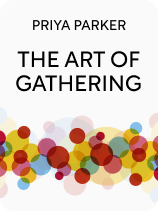

This article is an excerpt from the Shortform book guide to "The Art of Gathering" by Priya Parker. Shortform has the world's best summaries and analyses of books you should be reading.
Like this article? Sign up for a free trial here.
What are pop-up rules? Why do you need to create directives when planning an event?
According to Priya Parker in her book The Art of Gathering, pop-up rules (or “clear directives” as Priya calls them) are specific instructions about how you’d like your guests to behave during the event. For example, this could be a particular type of dish they should bring.
Let’s look at why pop-up rules make or break an event.
Creating Pop-Up Rules
Parker recommends creating pop-up rules, or creative directives, for two reasons. First, clear pop-up rules make diverse gatherings more comfortable. Many hosts expect their guests to behave according to certain defined protocols. However, this expectation often backfires in an increasingly multicultural world. If your guest list is diverse, they will have different (and potentially clashing) cultural expectations for what is appropriate; for example, a Japanese person will expect guests to help them clean up after a house party, while an American might find this practice insulting. Clear directives remove a lot of potential friction and pave the way for a smoother gathering.
(Shortform note: While clear directives may help make a diverse gathering more comfortable, they may not be enough. Another way to make diverse gatherings more comfortable is to use inclusive language, such as by introducing your guests to each other with their pronouns or by avoiding gendered terms like “boys and girls.” Modeling the behavior you want your guests to engage in is also another way in which you can make clear what you’d like your guests to do and so avoid the potential cultural clashes regarding correct behavior that Parker warns against.)
Second, Parker argues that clear directives encourage engagement. For example, people are often glued to their cell phones—even in situations when checking their phone is generally considered rude. But if you temporarily ban cell phones during your gathering, the short-term nature of this directive will make it seem more like a rule of a game. As a result, your guests will find pleasure in ignoring their cell phones rather than feeling restricted—and thus be more engaged within your gathering.
(Shortform note: While some directives may encourage engagement, not everybody agrees that a cell phone ban is an effective rule. One study found that people who had a fear of missing out experienced increased stress when they muted their phone notifications. So it’s possible that some guests, rather than viewing the cell phone ban as a game, will be so distracted by what they might be missing that they’ll be less engaged with your event. Additionally, certain events may benefit from cell phone usage. For example, you could encourage engagement at a big conference by asking people to Tweet questions to the speakers from their phones.)
Parker advises keeping two things in mind when creating directives. First, your directives should be one-time-only. This doesn’t mean that you can’t use the same directive (like no cell phones) for multiple events; rather, it means that the fact that one gathering is a certain way doesn’t mean that all subsequent gatherings will be that way. By making these directives one-time-only, you can experiment with different kinds of directives and create very specific moods at specific gatherings.
| When to Repeat Directives If you have a recurring gathering, you may wish to skip having one-time-only directives and instead repeat the same directives for each event while being open to changing them if necessary. Otherwise, guests may grow confused and frustrated at having to follow different directives at each gathering. It could also make it difficult for organizers to maintain control over the event if attendees feel that the directives are constantly changing. For example, some companies have “core norms” (behavioral guidelines that apply to participants at nearly all meetings) and “specialty norms” (behavioral guidelines that apply to participants at specific types of meetings). For example, you might have “if you think something is a bad idea, say so” as a core norm, but temporarily suspend that during a brainstorming meeting where the specialty norm is “name as many ideas as you can.” |
Second, while it’s better to explicitly communicate your directives to guests in advance, your directives can be spur-of-the-moment if necessary. For example, Parker once held a retreat for a Thai company. The retreat was designed to foster the consultants’ relationship with each other; however, the cultural expectation that the consultants were available to their clients at all times caused several consultants to repeatedly arrive late to several sessions. Parker created a spur-of-the-moment directive that any late consultant had to do push-ups; this directive encouraged people to arrive on time.
(Shortform note: Keep in mind that it’s difficult to create inclusive spur-of-the-moment directives—especially if you’re not familiar with your guests. Guests with physical or health limitations may feel uncomfortable with directives that involve physical exertion, like push-ups. Additionally, in a culturally diverse gathering, you may inadvertently offend certain guests if you don’t carefully consider their cultural expectations when creating spur-of-the-moment directives. You may be able to get around these risks by encouraging guests to share if they’re uncomfortable with the directives—but remember that this may not work in all cultures. For example, subordinates in some cultures often won’t speak unless explicitly called upon.)

———End of Preview———
Like what you just read? Read the rest of the world's best book summary and analysis of Priya Parker's "The Art of Gathering" at Shortform.
Here's what you'll find in our full The Art of Gathering summary:
- How to make pre-planned gatherings more meaningful and engaging
- What to do before, during, and after any type of gathering
- Why the host should never relax during their event






